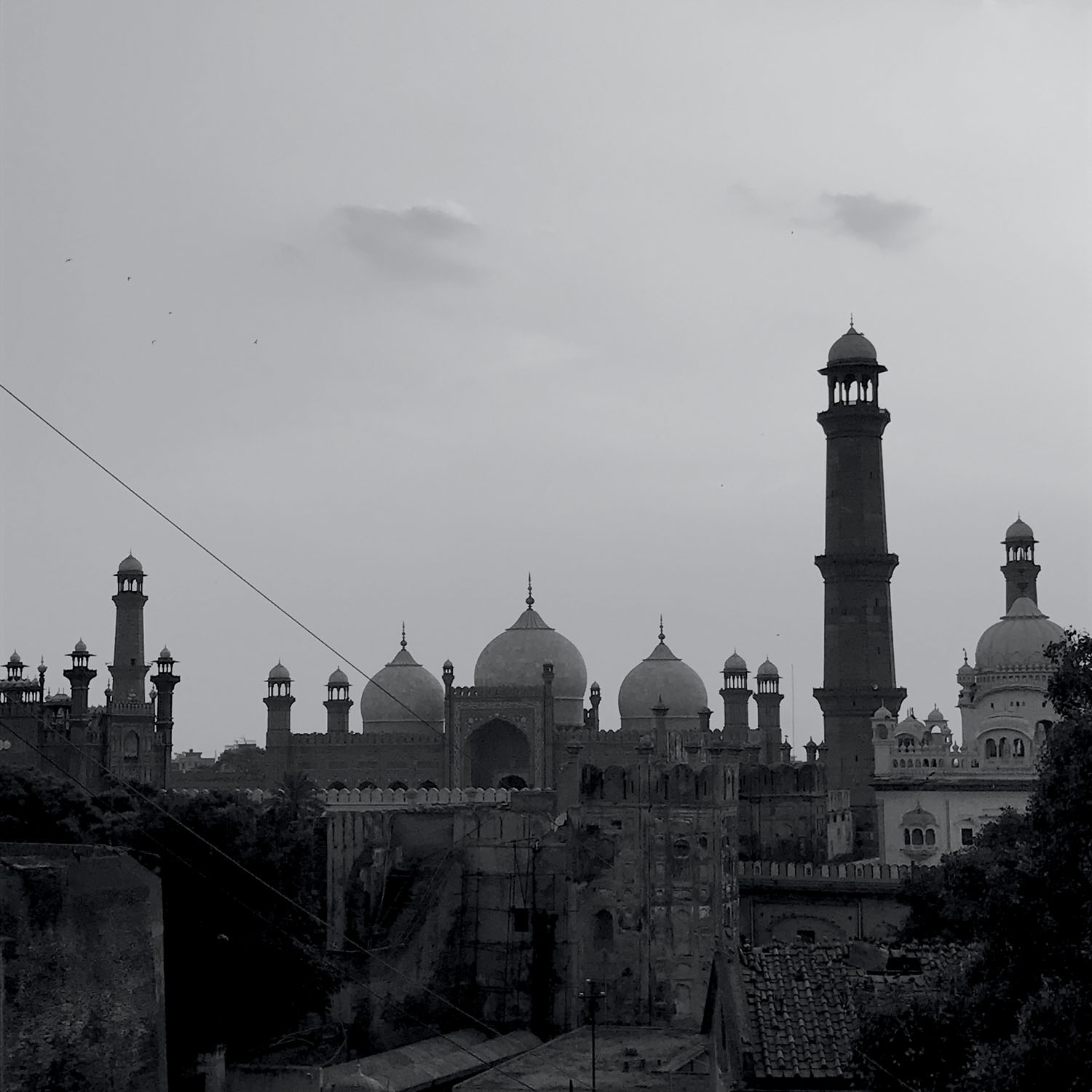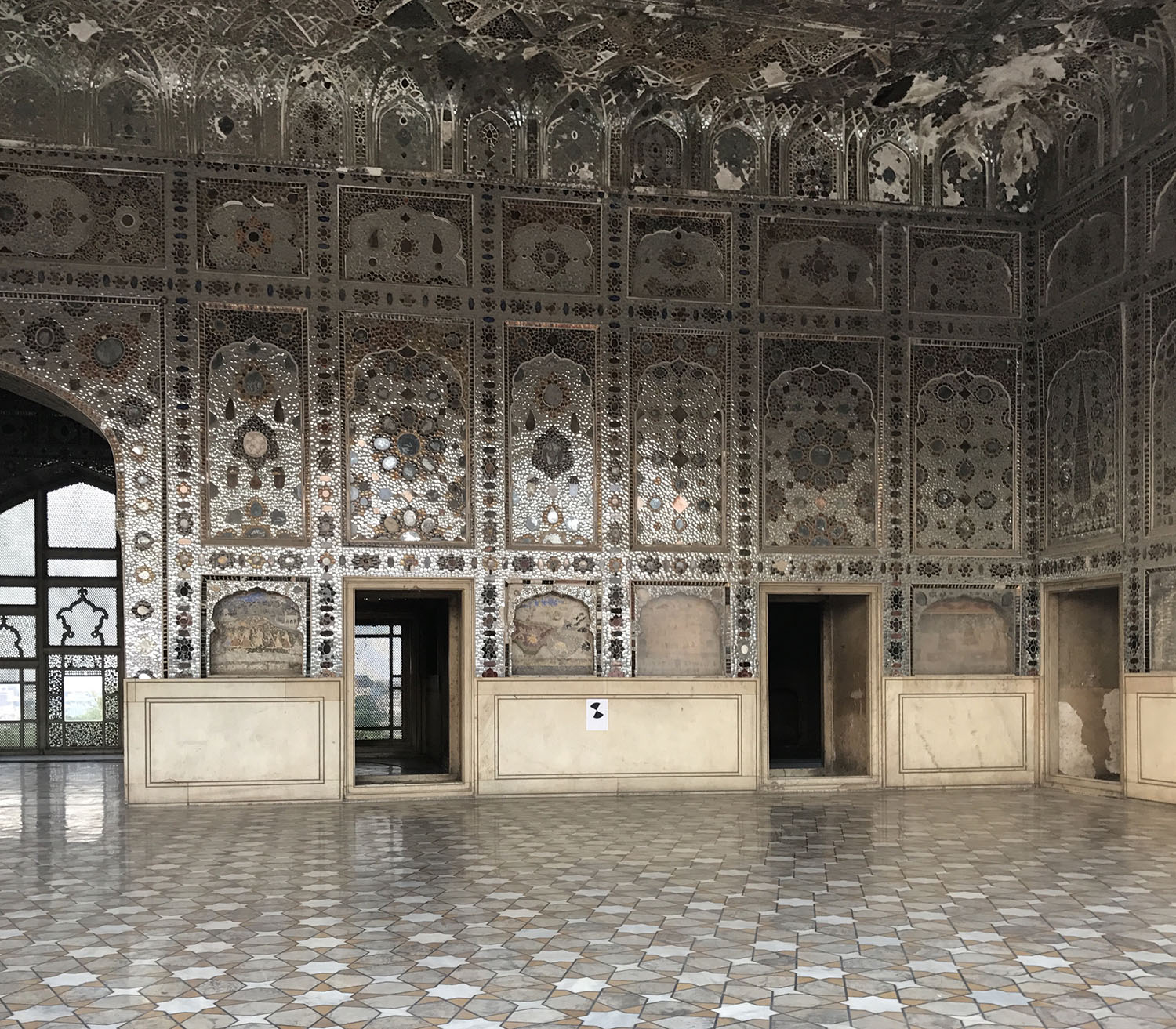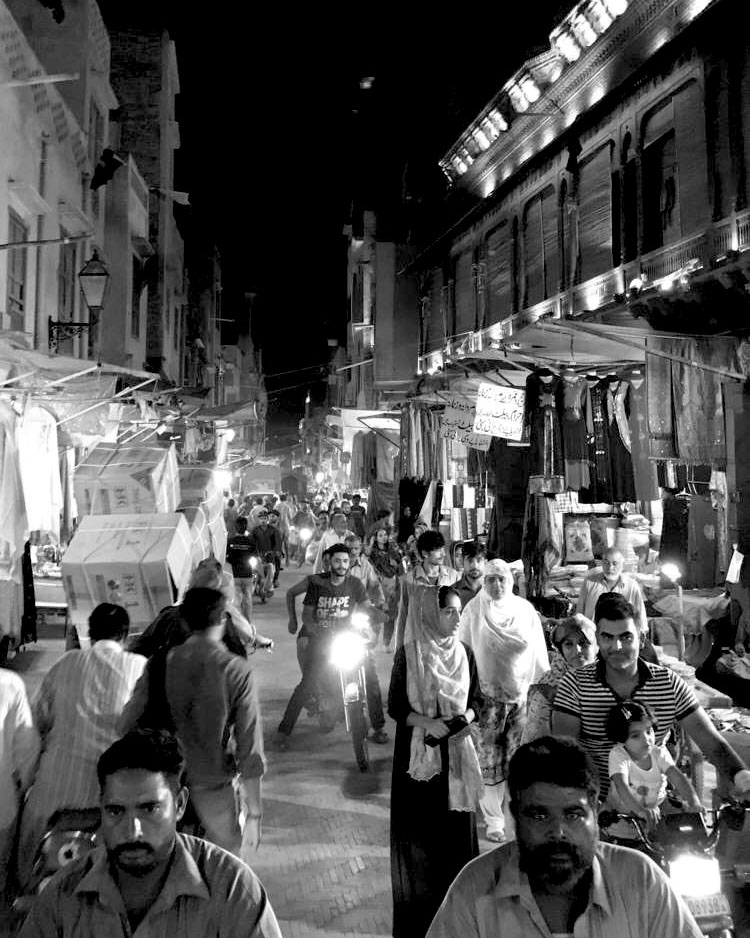1

Lahore is Lahore, the saying goes. For the twelve million who, until recently, made their way through its streets every day, that is all that needs to be said. For the others—the foreign, the displaced—it is an idea, resisting definition. Before the pandemic emptied the streets, I landed in a city I could still move through freely. Briefly, Lahore was a city I remembered from my childhood. Martial law was long gone but there were still soldiers posted at intersections along the banyan-lined roads. Behind them, new shopping malls flashed a familiar, gaudy fluorescence. My boys, strangers to this place, were fascinated. “They say you’re not born until you’ve seen Lahore,” I told them. “Get ready.” We could go anywhere, no need for caution. So we drove.
The story of Lahore is four thousand years old, although you wouldn’t know it passing the bright faces of billboarded pop stars posted along the road to the Old City. The English ads are landmarks of a new era: McDonald’s, Coke, Nissan. They announce that the world is welcome here. But Lahore, more than anything, is a city of walls. They separate house from road, old from new, visitor from local. Buildings with a modern aesthetic—clean lines, glass windows—stand beside nineteenth-century relics, those in turn still new compared to nearby seventeenth-century mosques and tombs. The architecture tells the story of Lahore’s cultural occupation; this story is being resuscitated for foreign consumption. We, too, consumed.
The heart of Lahore is the Old City. There, you’ll find the Badshahi Mosque, a fixture on postcards. This is the oldest neighborhood in town, a late-night destination for those looking for an expedition to brothels restored to rooftop restaurants with a view. The night we visited, the air hummed. I hurried my kids past street food, unsure their bodies could stomach the spicy rotiserries, roasted chickpeas, yams. At a set of gates to the Walled City, we took pictures of the stone lions left by Ranjeet Singh, a family ancestor and ruler of Punjab. I was pulled by the promise of a connection and so we followed the tight web of streets to the Fort, looking for the beginning.
2

Lahore is said to be named for Prince Lava, the son of the Hindu deities Rama and Sita. I pointed out to my sons the intersections between the city’s identity and mine: Greeks, maybe, the Sikhs, definitely. The Fort’s faded façade, the world’s biggest mural, is a tale of Mogul wars and conquests among paintings of Chinese dragons and Christian angels. Inside, the sixteenth-century brick walls are frescoes of Jesus and Madonna, gouged hollows where precious stones were once inlaid with intricate Islamic art. “I grew up with all these religions.” It was the only way to explain my Catholic-school-in-a-Muslim-country education to them. “Everything you see is a part of you.”
Inside the Fort, the remnants of the walls are glued together with the original cement made of bones and lentils and sugar. Bird after bird pecked at the jagged red brick—the same as the outer wall of my ancestral home, a few hundred kilometers away. “Is that where our ancestor is buried?” My son pointed at the domes of the mausoleum beyond the courtyard. “Cool.” A five-minute walk across the old treasury, we found the apartments above the Palace of Mirrors where Ranjeet Singh kept his harem. In the dressing room to the side where courtesans prepared, the mirrors were gone but tourists still lingered, posing in front of the walls where their reflections might have been. The window in the back gave us access to a newer Lahore. By March it would be empty. We looked out onto Minar-e-Pakistan, the birthplace of the idea of Pakistan and where, at eight, I walked in endless loops, hoping that I may have walked across the very spot where my grandfather had been. The surrounding Iqbal Park is now a place of family picnics and political rallies and, in 2016, a suicide bombing targeting Christians. There are other marks on the walls too, proclamations in the name of Allah or love. At every turn, we found evidence of visitors: names carved in stone, phone numbers of others searching for something, pushed to leave a trail like all other conquerors before them, compelled to say, “I was here.” The story of a city is created, continually, by those within it. I imagined my walking this space was significant; we, too, were becoming part of it.
3

Lahore has seen many religions, but across the city mosques far outnumber churches and temples. Faith is everywhere, though the fervor of belief shifts based on the temperament of the neighborhood. Even in the modern part of Lahore, the calls to prayer ring out five times a day and the Friday sermon and prayer is a necessary ritual for many, despite being only a stop on the holy day for those hurrying to more worldly things. In neighborhoods closer to the Old City, the loudspeakers on mosque minarets compete for attention at prayer time. In the age of COVID-19, some annoucements have communicated a different, defiant belief, an insistence that mosques are not subject to social distancing; prayer must not be stopped. But on the weekday we visited, the commitment of worshippers seemed perfunctory at best. At sunset, shopkeepers placed signs across their wares—back in five. Others continued, pausing only their conversation. A beggar ran her hand across my son’s head, then held it out to me. “May Allah give him a long life.” Our transaction was inexpensive; a hundred rupees for her blessings.//In the arched atrium of the pearl-shaped Moti Masjid—one of three mosques named so by Mogul emperors, the others being in Agra and Delhi—I saw a different divinity. The walls of this building, which has gone from mosque to temple to treasury to mosque, were a frenzy of Urdu, the women’s prayer room at the back a staggering, desperate cacophony of beseeching: “Please let me have a son”; “Bring my husband back”; “Let my son get his visa to America”; “Let my sister’s husband fall in love with her.” In blood, someone had begged djinns— unseen and unwelcome fiery beings—for help, any help. In this country, a declared Islamic republic, where British colonialism has left a heavy mark (on architecture, on the operating language of the government, on TV, on the schools) this mosque felt rebellious. A perfect consonance, I thought, this coming together of the city and language, products of conquests. I knelt on the faded green rug. My skin felt as hot as fire. Unbidden, in my mind, Urdu swam: yahaan,here.
4

Steps away from the Fort are the streets of the Old City where, during our visit, people still met freely, where social distancing was not even a concept; life swelled. We walked the narrow streets in a line along the wall, leaving just enough room for a bicycle or another body to pass by. Contained within the six remaining gates are some of the descendants of citizens who presented themselves before the Mogul kings at the Hall of Audience just feet away. They inhabit the same homes, child after child staying close to Lahore’s heart. We spied their lives through gauzy windows: mattresses on the floor, a tin of rose talcum powder, a broken and naked doll. Small shops abound in the Old City: electronics, fabric-dyeing shops, a cobbler. We were part of the outside world, trickling in to buy little pieces of theirs, the souvenirs packing the streets. Some stalls sell imported kitsch: My son wanted an Anonymous mask—a local memento, in his eyes. Pakistan has inherited imperialist symbols, so perhaps he wasn’t wrong. “The Batman is too American,” he said. The narrowest street of the city is barely forty inches across. We came to a blue doorway, thrown open. A man shoveled rice into a plastic bag. A pregnant woman stood just inside with a baby in her arms, two toddlers by her side. She looked at me and it felt as if a border had appeared between us: My Lahore and hers are not the same.
The woman’s child tugged at her hair and she looked away. I slid past. It was not until a few minutes later, after someone passing on a bicycle had uttered it, and my son in turn asked what a farangi was, that I realized what our presence in this city meant: foreigner, colonizer, other. Someone had seen us wandering, intruding, infecting this place with our presence. I wanted to protest: I am not just passing through, this is my home. But our jeans and cameras and eager faces told a different story. We had offended, trying to get to know this place. A wasted endeavor, it turns out. By spring the city shifted again, and again Lahore has become just an idea I once had.






